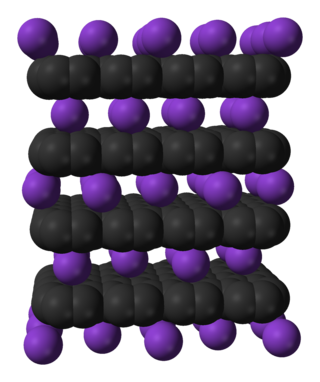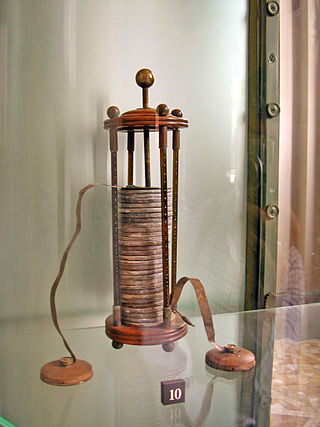
An electrode is an electrical conductor used to make contact with a nonmetallic part of a circuit. Electrodes are essential parts of batteries that can consist of a variety of materials depending on the type of battery.

A lithium-ion or Li-ion battery is a type of rechargeable battery that uses the reversible intercalation of Li+ ions into electronically conducting solids to store energy. In comparison with other commercial rechargeable batteries, Li-ion batteries are characterized by higher specific energy, higher energy density, higher energy efficiency, a longer cycle life, and a longer calendar life. Also noteworthy is a dramatic improvement in lithium-ion battery properties after their market introduction in 1991: within the next 30 years, their volumetric energy density increased threefold while their cost dropped tenfold.

John Bannister Goodenough was an American materials scientist, a solid-state physicist, and a Nobel laureate in chemistry. From 1996 he was a professor of Mechanical, Materials Science, and Electrical Engineering at the University of Texas at Austin. He is credited with identifying the Goodenough–Kanamori rules of the sign of the magnetic superexchange in materials, with developing materials for computer random-access memory and with inventing cathode materials for lithium-ion batteries.

In chemistry, intercalation is the reversible inclusion or insertion of a molecule into layered materials with layered structures. Examples are found in graphite and transition metal dichalcogenides.

Lithium metal batteries are primary batteries that have metallic lithium as an anode. The name intentionally refers to the metal to as to distinguish them from lithium-ion batteries, which use lithiated metal oxides as the cathode material. Although most lithium metal batteries are non-rechargeable, rechargeable lithium metal batteries are also under development. Since 2007, Dangerous Goods Regulations differentiate between lithium metal batteries and lithium-ion batteries.

Michael Stanley Whittingham is a British-American chemist. He is a professor of chemistry and director of both the Institute for Materials Research and the Materials Science and Engineering program at Binghamton University, State University of New York. He also serves as director of the Northeastern Center for Chemical Energy Storage (NECCES) of the U.S. Department of Energy at Binghamton. He was awarded the Nobel Prize in Chemistry in 2019 alongside Akira Yoshino and John B. Goodenough.

Nanobatteries are fabricated batteries employing technology at the nanoscale, particles that measure less than 100 nanometers or 10−7 meters. These batteries may be nano in size or may use nanotechnology in a macro scale battery. Nanoscale batteries can be combined to function as a macrobattery such as within a nanopore battery.

Batteries provided the primary source of electricity before the development of electric generators and electrical grids around the end of the 19th century. Successive improvements in battery technology facilitated major electrical advances, from early scientific studies to the rise of telegraphs and telephones, eventually leading to portable computers, mobile phones, electric cars, and many other electrical devices.
The Electrochemical Society is a learned society based in the United States that supports scientific inquiry in the field of electrochemistry solid-state science and related technology. The Society membership comprises more than 8,000 scientists and engineers in over 85 countries at all degree levels and in all fields of electrochemistry, solid-state science and related technologies. Additional support is provided by institutional members including corporations and laboratories.
A nanowire battery uses nanowires to increase the surface area of one or both of its electrodes, which improves the capacity of the battery. Some designs, variations of the lithium-ion battery have been announced, although none are commercially available. All of the concepts replace the traditional graphite anode and could improve battery performance. Each type of nanowire battery has specific advantages and disadvantages, but a challenge common to all of them is their fragility.
A potassium-ion battery or K-ion battery is a type of battery and analogue to lithium-ion batteries, using potassium ions for charge transfer instead of lithium ions. It was invented by the Iranian/American chemist Ali Eftekhari in 2004.

Akira Yoshino is a Japanese chemist. He is a fellow of Asahi Kasei Corporation and a professor at Meijo University in Nagoya. He created the first safe, production-viable lithium-ion battery, which became used widely in cellular phones and notebook computers. Yoshino was awarded the Nobel Prize in Chemistry in 2019 alongside M. Stanley Whittingham and John B. Goodenough.
Research in lithium-ion batteries has produced many proposed refinements of lithium-ion batteries. Areas of research interest have focused on improving energy density, safety, rate capability, cycle durability, flexibility, and cost.
A dual carbon battery is a type of battery that uses graphite as both its cathode and anode material. Compared to lithium-ion batteries, dual-ion batteries (DIBs) require less energy and emit less CO2 during production, have a reduced reliance on critical materials such as Ni or Co, and are more easily recyclable.
Lithium–silicon batteries are lithium-ion battery that employ a silicon-based anode and lithium ions as the charge carriers. Silicon based materials generally have a much larger specific capacity, for example 3600 mAh/g for pristine silicon, relative to the standard anode material graphite, which is limited to a maximum theoretical capacity of 372 mAh/g for the fully lithiated state LiC6.
Jeff Dahn is a Professor in the Department of Physics & Atmospheric Science and the Department of Chemistry at Dalhousie University. He is recognized as one of the pioneering developers of the lithium-ion battery, which is now used worldwide in laptop computers, cell-phones, cars and many other mobile devices. Although Dr. Dahn made numerous contribution to the development of lithium-ion batteries, his most important discovery was intercalation of Li+ ions into graphite from solvents comprising ethylene carbonate, which was the final piece of the puzzle in the invention of commercial Li-ion battery. Nevertheless, Dahn was not selected for the 2019 Nobel Prize in Chemistry, which recognized only John Goodenough, M. Stanley Whittingham and Akira Yoshino.

Kristina Edström is a Swedish Professor of Inorganic Chemistry at Uppsala University. She also serves as Head of the Ångström Advanced Battery Centre (ÅABC) and has previously been both Vice Dean for Research at the Faculty of Science and Technology and Chair of the STandUp for Energy research programme.
Yayuan Liu is a Chinese-American materials scientist at the Massachusetts Institute of Technology. Her research considers electrochemistry, nanomaterials, and materials characterisation for the development of next-generation batteries. She was selected as one of the 2019 American Chemical Society Young Investigators and included in the 2021 Forbes 30 Under 30 list of top scientists.

This is a history of the lithium-ion battery.
Karim Zaghib is an Algerian-Canadian electrochemist and materials scientist known for his contributions to the field of energy storage and conversion. He is currently Professor of Chemical and Materials Engineering at Concordia University. As former director of research at Hydro-Québec, he helped to make it the world’s first company to use lithium iron phosphate in cathodes, and to develop natural graphite and nanotitanate anodes.











